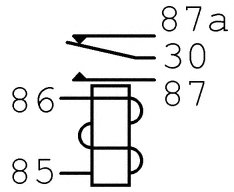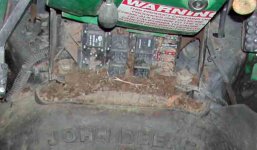You are using an out of date browser. It may not display this or other websites correctly.
You should upgrade or use an alternative browser.
You should upgrade or use an alternative browser.
testing relays
- Thread starter kak
- Start date
/ testing relays
#1
LD1
Epic Contributor
How are electrical relays tested? I have a JD 4300 and I suspect that there may be a bad relay preventing the engine starting (won't crank when the key is turned). Thanks!
--Karl
There are several types of relays but the most common are the little ice-cube relays. About 1.5" square and have 4 terminals. I'll assume you are talking about them.
The terminals are usually labled 85, 86, 87, and 30.
85 and 86 is the control side of the relay and create a magnetic field to close the "switch" between terinals 87 and 30.
The easiest way to test is to check for continuity between 87 and 30. There sould be none, or the switch open.
Then add 12v to 85 and ground 86 and see it the continuity between 87 and 30 goes to 0 ohms (switch closes).
Some relays have an 87a terminal which is a normally closed terminal. meaning it has power (continuity with 30) without 85 and 86 having power and ground, and opens (no continuity) when power and groung are applied to 85 and 86.
Additionally, some relays are controlled with the ground wire on 86 and otherswith the 12v on 85. Depending on your tractor, it may have 12v all the time on 85 and when you what to enetgize the relay, in closes the switch and allows 86 to ground. Others have 86 grounded all the time and when the relay needs to be energized, it supplies 12v to 85.
Dont know about Deer, but most starter motors have a solenoid that does two things;
First there are heavy duty contacts that carry the 200+ amps that run the starter motor.
Second, the solenoid slides a gear along the starter motor shaft that engages with the flywheel ring gear to spin the engine.
The relay that you refer to may be the switch that sends current to the solenoid.
First there are heavy duty contacts that carry the 200+ amps that run the starter motor.
Second, the solenoid slides a gear along the starter motor shaft that engages with the flywheel ring gear to spin the engine.
The relay that you refer to may be the switch that sends current to the solenoid.
kebo
Elite Member
- Joined
- May 16, 2006
- Messages
- 2,910
- Location
- Lexington, SC
- Tractor
- 2001 John Deere 790 4x4, bar tires
Relays are pretty simple. The coil must be energized for the contacts to actuate. However, depending on how one is designed, it will have either NC (Normally Closed) or NO (Normally Open) contacts. The ones that are NC you should measure near zero ohms across the contacts with no voltage applied to the relay. When the coil is energized, NC contacts should read infinite resistance (open).
For NO contacts, they will measure infinite resistance with the coil de-energized. Once the coil is energized, they should read near zero ohms through them. Oftentimes a relay will have both NC and NO contacts.
The contacts can become corroded over time, especially in humid environments or if they have poor weather sealing. They can also become burned due to arcing over being closed or opened during many cycles of operation.
The coil itself can open up (near infinite resistance measured across it) which means it will not energize. Or, it can have shorted turns (lower resistance than it should measure), this condition may or may not let it energize. The only way to know the proper dc coil resistance that you should measure is to have another known good one (same type) to compare with, or have the manufacturers spec's to it handy to refer to.
For NO contacts, they will measure infinite resistance with the coil de-energized. Once the coil is energized, they should read near zero ohms through them. Oftentimes a relay will have both NC and NO contacts.
The contacts can become corroded over time, especially in humid environments or if they have poor weather sealing. They can also become burned due to arcing over being closed or opened during many cycles of operation.
The coil itself can open up (near infinite resistance measured across it) which means it will not energize. Or, it can have shorted turns (lower resistance than it should measure), this condition may or may not let it energize. The only way to know the proper dc coil resistance that you should measure is to have another known good one (same type) to compare with, or have the manufacturers spec's to it handy to refer to.
I don't think most tractors have the "ice cube" relay involved in the starter circuit, but LD1 explained that nicely if you do have one. Make sure your battery is good. You should have 12.6 volts to begin testing. Find your starter and unplug the small wire at the solenoid. Check to see if you have 12v supplied to it while ignition key is in the crank/start position. If you do, make sure your big wire at the solenoid has 12v, and a good clean connection. If you don't have 12v at the small wire when attempting to start, you need to work backwards through the wiring to find out why. Safety switches on seats or ptos or transmission linkage could be involved.
KB9UDE
Veteran Member
- Joined
- Apr 23, 2006
- Messages
- 1,065
- Location
- North of Tower Hill, IL
- Tractor
- John Deere 3320 John Deere x758
I am also thinking it could be a safey switch
mostly_gas
Super Member
And be careful about whether the safety switch is normal closed or normal open. I had real fun with a Rx75 until I worked out the seat switch is normal closed. (to by pass the switch simply unplug).
dfkrug
Super Member
- Joined
- Feb 3, 2004
- Messages
- 7,174
- Location
- Santa Cruz Mtns, CA
- Tractor
- 05 Kioti CK30HST w/ Prairie Dog backhoe, XN08 mini-X
I have a JD 4300 and I suspect that there may be a bad relay preventing the engine starting (
Karl, here is a photo of your fuse panel. Hopefully yours is cleaner. Most
if not all of your relays are the same kind (well-described by LD1). You
can swap the relays around to test them, as well as using an Ohm meter
and a battery. I do suggest that you look at the electrical diagram to see
what each one is for. Also the various safety switches are more likely
your problem, vs the relays.
Since these are standard plug-in automotive relays, you don't have to
get them from Deere. I used Bosch units for my replacements.
Attachments
MicroPilot
Veteran Member
There are several types of relays but the most common are the little ice-cube relays. About 1.5" square and have 4 terminals. I'll assume you are talking about them.
The terminals are usually labled 85, 86, 87, and 30.
85 and 86 is the control side of the relay and create a magnetic field to close the "switch" between terinals 87 and 30.
The easiest way to test is to check for continuity between 87 and 30. There sould be none, or the switch open.
Then add 12v to 85 and ground 86 and see it the continuity between 87 and 30 goes to 0 ohms (switch closes).
Some relays have an 87a terminal which is a normally closed terminal. meaning it has power (continuity with 30) without 85 and 86 having power and ground, and opens (no continuity) when power and groung are applied to 85 and 86.
Additionally, some relays are controlled with the ground wire on 86 and otherswith the 12v on 85. Depending on your tractor, it may have 12v all the time on 85 and when you what to enetgize the relay, in closes the switch and allows 86 to ground. Others have 86 grounded all the time and when the relay needs to be energized, it supplies 12v to 85.
This page has a diagram and pictures of the type of relay LD1 describes. Basic Wiring - Custom Airbrush Work and Radical Customizing
Here is another simpler diagram of this relay

MikeBurr
Silver Member
This may or may not help. I'm guessing you are thinking one of the relays aren't working. Maybe you need to check your ground. My NH was having starting problems, after replaceing several parts- some were relays - I removed the grounding cable at the frame - It look good, but the back side was really bad. After sanding the cable back and the tractor frame contact point - and reinstalling on the tractor it now starts just fine.
